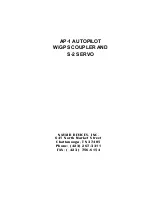
- 6 -
NOTE: A longer crank radius dictates a correspondingly longer radius at the drive end.
The ailerons must travel from aileron stop to aileron stop within the range of
movement allowed by the servo stops that limit crank arm rotation.
The mounting place must be strong and rigid-conceivably a lateral force of up to 50
pounds could be encountered. If, for example, you need to mount the servo on the skin of
an airplane, it probably will be necessary to use additional bracing or a doubler to provide
appropriate rigidity. You do not want the push-pull of the servo to fatigue the metal that
holds it.
Usually the servo pushrod will terminate on a control stick, a bellcrank, or perhaps a
lever sticking off of a torque tube. But in some cases (EZs, for example) it is more
convenient to terminate on an aileron control pushrod, in which case care should be taken
to keep the pushrod from being free to rotate. To do this, loosen the jam nut that secures
the rod end bearing in the pushrod, rotate the pushrod and jam nut in opposite directions
to remove any rotational slack, and retighten the jam nut. The reasoning for this is as
follows:
The servo pushes or pulls on a saddle bracket mounted on an aileron control pushrod, the
attach point being offset maybe an inch from the centerline of the control pushrod. If the
two pushrods are not perfectly aligned, the control pushrod may rotate instead of moving
sideways. Rotating, instead of moving, has the effect of putting play, or slack, into the
linkage, and the control movements in track mode are so small that it takes very little
slop in the system to make the airplane not track properly.
It will simplify installation adjustments if there is enough overhead clearance to allow
removal and replacement of the servo lid with the servo remaining in place. The servo lid
is secured by four screws at the side of the box. But, if it is more convenient, the lid may
be secured through holes in the top of the lid. There are two pots (potentiometers) and a
nut on the output shaft which should be adjusted with the lid off.
INSTALL THE CRANK ARM SERVO
Mount the servo without connecting the pushrod. See Fig. 3 on the next page and the
loose sheet showing how to solder the connector pins. The power and ground conductors
should be # 18 or larger. The servo signal wire carries little current and may be as small
as #24 stranded. If you also wish to hook up your nav receivers at this time, further
discussion starts on page 11.
Содержание AP-1
Страница 2: ......
Страница 9: ...7 WIRING DIAGRAM FOR HAND HELD GPS AND AP 1 WITH GPS COUPLER WIRING DIAGRAM Fig 3...
Страница 27: ...A 3...









































